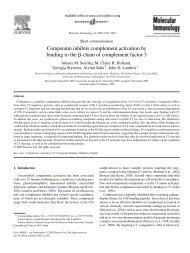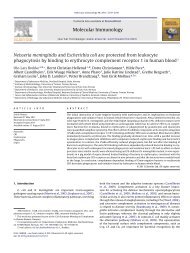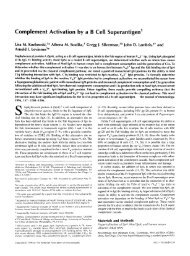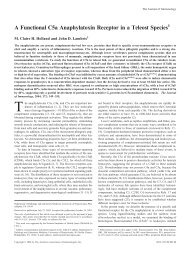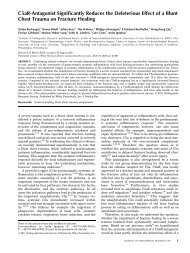IDENTIFICATION OF A C3bi-SPECIFIC ... - John D. Lambris
IDENTIFICATION OF A C3bi-SPECIFIC ... - John D. Lambris
IDENTIFICATION OF A C3bi-SPECIFIC ... - John D. Lambris
Create successful ePaper yourself
Turn your PDF publications into a flip-book with our unique Google optimized e-Paper software.
GORDON D. ROSS AND JOHN D. LAMBRIS 99<br />
a fluorescein isothiocyanate (FITC)-linked stain specific for either surface Ig, Leu-1 or 3A1 T<br />
cell antigens, or OKM-1 monocyte-null cell determinant, and then examined for rosette<br />
formation with rhodamine-stained <strong>C3bi</strong>-ms. For Ig staining, cells were treated with 25/zl of<br />
F(ab')2-anti-IgM, IgD, IgA, IgG-fluorescein (N. L. Cappel Laboratories, Cochranville, Pa.). For<br />
T cell staining, 'cells were treated with a 45-p.1 mixture containing 2.0/~g of protein-A-FITC<br />
(Pharmacia Fine Chemicals) and 1.0 p.g of either mouse IgG-anti-Leu-1 (B-D FACS Systems,<br />
Beeton, Dickinson & Co., Sunnyvale, Calif.), mouse IgG-anti-3A1 (27) (kindly donated by Dr.<br />
George Eisenbarth, Duke University, Durham, N. C.), or mouse IgG-anti-OKM-I (Ortho<br />
Pharmaceutical, Raritan, N. J.). Next, to enhance the monoclonal antibody FITC staining, the<br />
washed cells were stained in addition with FITC-F(ab')2-anti-mouse IgG (N. L. Cappel<br />
Laboratories). Finally, the fluorescein-stained cells were resuspended in 100/zl of BDVEA and<br />
assayed for CRs by addition of 100 ~1 of rhodamine-<strong>C3bi</strong>-ms. Cells were examined sequentially<br />
for fluorescein and/or rhodamine staining. In each case the anti-CR2-treated cells were also<br />
tested for complete absence of the ability to rosette with C3d-ms.<br />
Results<br />
Binding of <strong>C3bi</strong> Complexes to Various Leukocyte Types and Erythrocytes. Both E<strong>C3bi</strong> and<br />
<strong>C3bi</strong>-ms bound to a proportion of lymphocytes, erythrocytes, neutrophils, and monocytes<br />
(Table I). In all cases, <strong>C3bi</strong>-ms bound to a greater percentage of cells than did<br />
E<strong>C3bi</strong>. The increased binding of <strong>C3bi</strong>-ms was particularly apparent with erythrocytes,<br />
92% of which bound <strong>C3bi</strong>-ms, and 10% or less bound E<strong>C3bi</strong>. Only lymphoid cells<br />
bound C3d complexes. Immature monocytes and myeloid cells isolated from patients<br />
with either acute monocytic leukemia or chronic myelogenous leukemia were also<br />
negative for binding of C3d complexes.<br />
Specificity of <strong>C3bi</strong>-dependent Rosette Formation. The specificity of <strong>C3bi</strong> complex binding<br />
was examined by assays for inhibition of rosette formation, either by treatment of<br />
the C receptor cells with Fab' anti-C-receptor antibodies or fluid-phase C3 fragments<br />
(Table II) or by treatment of the C3 complexes with Fab anti-C3c or Fab anti-C3d<br />
antibodies (Table III). With all cell types, C3b-ms rosettes were inhibited by anti-<br />
CR1, fluid-phase C3b and fluid-phase C3c but not by anti-CR2, fluid-phase <strong>C3bi</strong>, or<br />
fluid-phase C3d. By contrast, <strong>C3bi</strong>-ms rosettes were not inhibited by anti-CR1, fluidphase<br />
C3b, or fluid-phase C3c. Thus, neither <strong>C3bi</strong>-ms nor fluid-phase <strong>C3bi</strong> bound to<br />
CR1 on any cell type. With erythrocytes, neutrophils, and monocytes, <strong>C3bi</strong>-ms rosettes<br />
were inhibited by fluid-phase <strong>C3bi</strong> but not by anti-CR1, anti-CR2, fluid-phase C3b,<br />
C3c, or C3d. Therefore, with these nonlymphoid cell types, <strong>C3bi</strong>-ms were bound to<br />
Downloaded from www.jem.org on November 8, 2004<br />
TABLE I<br />
EC3 and C3-ms Rosette Formation with Lymphocytes, E(ythrocytes,<br />
Neutrophils, and Monocytes<br />
Blood lymphocytes<br />
Lymphoblastoid lines<br />
Raji 0 0<br />
Daudi 0 0<br />
BF 98 L00<br />
Erythrocytes 75 95<br />
Neutrophils 95 100<br />
Monocytes 85 95<br />
* Assayed in the presence of 1.0 mg/ml of STI.<br />
EC3b C3b-ms E<strong>C3bi</strong> <strong>C3bi</strong>-ms EC3d C3d-ms<br />
% % % % % %<br />
16 17 [0 12 7 9<br />
99 100 98 100<br />
84 96 86 95<br />
98 99 97 98<br />
10 92 0 0<br />
75* 89* 0 0<br />
84 91 0 0





